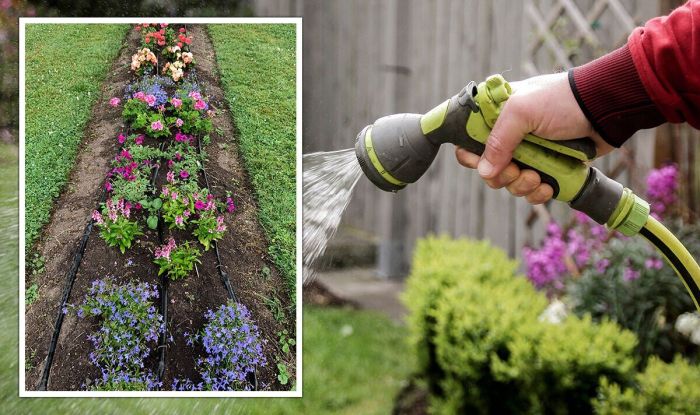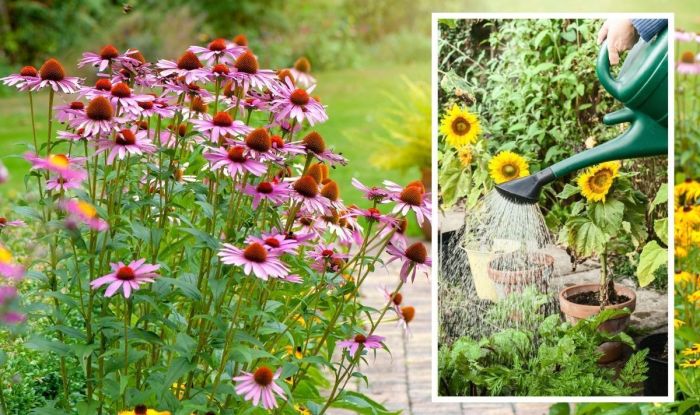How Often to Water Plants in Summer
Factors Affecting Watering Frequency: How Often To Water Plants In Summer
How often to water plants in summer – The frequency with which you water your plants during summer depends on several interacting factors. Understanding these factors is crucial for maintaining healthy, thriving plants.
Temperature’s Impact on Plant Water Needs
Higher temperatures lead to increased evaporation from the soil and transpiration from the plant leaves. This means plants in hot summer conditions will require more frequent watering than those in cooler environments. A sudden heatwave, for instance, will dramatically increase a plant’s water needs. Conversely, cooler days will necessitate less frequent watering.
Sunlight Exposure and Watering Schedules
Plants exposed to full sun dry out much faster than those in shade or partial shade. Plants in direct sunlight will need more frequent watering to compensate for the rapid evaporation of water from the soil. Plants in shadier locations generally need less frequent watering.
Watering Needs for Different Plant Types
Different plant types have varying water requirements. Succulents, for example, are adapted to arid conditions and store water in their leaves and stems, requiring infrequent watering. Leafy greens, on the other hand, need consistently moist soil and more frequent watering to thrive. Similarly, drought-tolerant plants need less water than those that prefer consistently moist soil.
Humidity’s Influence on Watering Frequency
High humidity reduces the rate of evaporation from the soil and transpiration from the plant leaves. In humid climates, plants may require less frequent watering compared to drier climates. Conversely, low humidity accelerates drying, necessitating more frequent watering.
Watering Needs Based on Container Size and Material
The size and material of the container also influence watering frequency. Smaller pots dry out faster than larger ones, requiring more frequent watering. Terracotta pots are porous and allow for greater evaporation, leading to increased watering needs compared to plastic or glazed ceramic pots which retain moisture longer.
| Container Size | Material | Watering Frequency (Example – Adjust based on other factors) |
|---|---|---|
| Small (under 6 inches) | Terracotta | Daily or every other day |
| Medium (6-12 inches) | Plastic | Every 2-3 days |
| Large (over 12 inches) | Glazed ceramic | Every 3-5 days |
| Small (under 6 inches) | Plastic | Every other day |
Signs of Overwatering and Underwater
Recognizing the signs of both overwatering and underwatering is crucial for maintaining healthy plants. Early detection allows for timely intervention, preventing irreversible damage.
Summer watering schedules for plants depend heavily on factors like sun exposure and plant type. To understand the need for consistent moisture, consider why rice thrives submerged in water; it’s a fascinating example of a plant with unique water requirements, as explained in this article: why is rice planted in water. This highlights how different plants have vastly different hydration needs, emphasizing the importance of careful observation when watering your summer garden.
Visual Symptoms of Overwatering
Overwatered plants often exhibit yellowing or browning leaves, especially the lower ones. The leaves may become limp and droopy, even though the soil is saturated. In severe cases, the stem may become soft and mushy, and a foul odor may develop due to root rot.
Physical Signs of Underwater
Underwatered plants display wilting leaves that are dry and brittle. The soil will be completely dry to the touch, and the plant may appear stunted or its growth may be significantly slowed. The leaves may curl or droop dramatically, and the soil may pull away from the sides of the pot.
Touch-Based Indicators of Overwatering and Underwatering

Source: redd.it
- Overwatering: Soil feels soggy and waterlogged, even after a few days.
- Underwatering: Soil is completely dry, even several inches below the surface.
Recovery Methods for Overwatered and Underwatered Plants
Recovery methods differ significantly. Overwatered plants need repotting with fresh, well-draining soil, and possibly trimming of affected roots. Underwatered plants require thorough deep watering until water drains from the bottom, allowing the soil to rehydrate.
Watering Techniques and Methods

Source: co.uk
Several watering techniques exist, each with its own advantages and disadvantages. Choosing the right method depends on the plant type, container size, and personal preference.
Different Watering Methods
Top watering involves pouring water directly onto the soil surface. Bottom watering involves placing the pot in a tray of water, allowing the soil to absorb moisture from below. Drip irrigation delivers water slowly and directly to the roots.
Advantages and Disadvantages of Watering Methods
| Watering Method | Advantages | Disadvantages |
|---|---|---|
| Top Watering | Simple, convenient | Can lead to surface runoff, uneven watering |
| Bottom Watering | Even watering, less runoff | Slower, requires more attention |
| Drip Irrigation | Efficient, targeted watering | More expensive to set up |
Checking Soil Moisture Levels
Before watering, check the soil moisture by inserting your finger about an inch into the soil. If the soil feels dry, it’s time to water. For larger pots, check at several depths.
Deep and Effective Watering
- Water slowly and deeply until water drains from the drainage holes.
- Allow excess water to drain completely; do not let plants sit in standing water.
- Repeat as needed, based on the factors discussed above.
Seasonal Adjustments and Considerations

Source: co.uk
Watering needs change throughout the summer. Adjusting your watering schedule based on weather conditions is crucial for plant health.
Changes in Watering Frequency as Summer Progresses
As summer progresses, temperatures often increase, leading to increased evaporation and thus, a need for more frequent watering. However, periods of rain may reduce the frequency needed.
Adjusting Watering Based on Rainfall
Rainfall reduces the need for supplemental watering. Monitor rainfall amounts and adjust your watering schedule accordingly. Heavier rains may eliminate the need for watering for several days.
Watering During Heat Waves
During heat waves, plants need more frequent watering, possibly even twice a day for some plants. Water deeply in the early morning or evening to minimize evaporation.
Importance of Adequate Drainage
Well-draining soil is essential to prevent overwatering. Ensure your pots have drainage holes and use a potting mix that allows for good water drainage. Avoid letting plants sit in standing water.
Specific Plant Examples and Watering Needs
Different plants have different watering needs. Understanding these needs is key to successful gardening.
Watering Frequencies for Common Summer Plants
| Plant | Watering Frequency (Example – Adjust based on other factors) |
|---|---|
| Tomatoes | Every 2-3 days |
| Basil | Daily or every other day |
| Petunias | Daily or every other day |
| Succulents | Once a week or less |
Detailed Descriptions of Watering Needs
Tomatoes: Tomatoes require consistently moist but not waterlogged soil. Water deeply at the base of the plant, avoiding wetting the leaves to prevent fungal diseases.
Basil: Basil prefers consistently moist soil. Allow the top inch of soil to dry slightly between waterings. Water more frequently during hot, dry weather.
Succulents: Succulents store water in their leaves, so they need less frequent watering. Water thoroughly when the soil is completely dry, allowing the soil to dry out completely between waterings. Overwatering is a common problem with succulents.
Plants Tolerating Drought vs. Frequent Watering
Drought-tolerant plants: Lavender, rosemary, cacti.
Plants requiring frequent watering: Lettuce, spinach, impatiens.
Illustrative Examples
Visual representations can help to better understand the effects of proper and improper watering.
Properly Watered Plant, How often to water plants in summer
A properly watered plant displays vibrant, upright leaves with a healthy green color. The soil is moist but not soggy, and the plant shows strong, healthy growth. The leaves are firm and turgid (not droopy or wilted).
Overwatered Plant
An overwatered plant has yellowing or browning leaves, particularly the lower ones. The leaves are limp and droopy, even though the soil is saturated. The stem may be soft and mushy, and a foul odor may be present. The soil may be visibly waterlogged.
Underwatered Plant
An underwatered plant has dry, brittle, and wilted leaves. The soil is completely dry, and the plant appears stunted. The leaves may be curled or severely drooped. The plant may be showing signs of stress, such as leaf browning and dropping.
Essential FAQs
What if I accidentally overwater my plants?
Allow the soil to dry out partially before watering again. Improve drainage if necessary. In severe cases, repotting may be needed.
How can I tell if my plants need more frequent watering?
Check the soil moisture; if it’s dry an inch or two below the surface, it’s time to water. Wilting leaves and drooping stems are also clear indicators.
What’s the best time of day to water plants?
Early morning is ideal, allowing leaves to dry before nightfall and reducing the risk of fungal diseases.
Can I use tap water to water my plants?
Generally yes, but letting tap water sit for 24 hours allows chlorine to dissipate, which is beneficial for many plants.




















